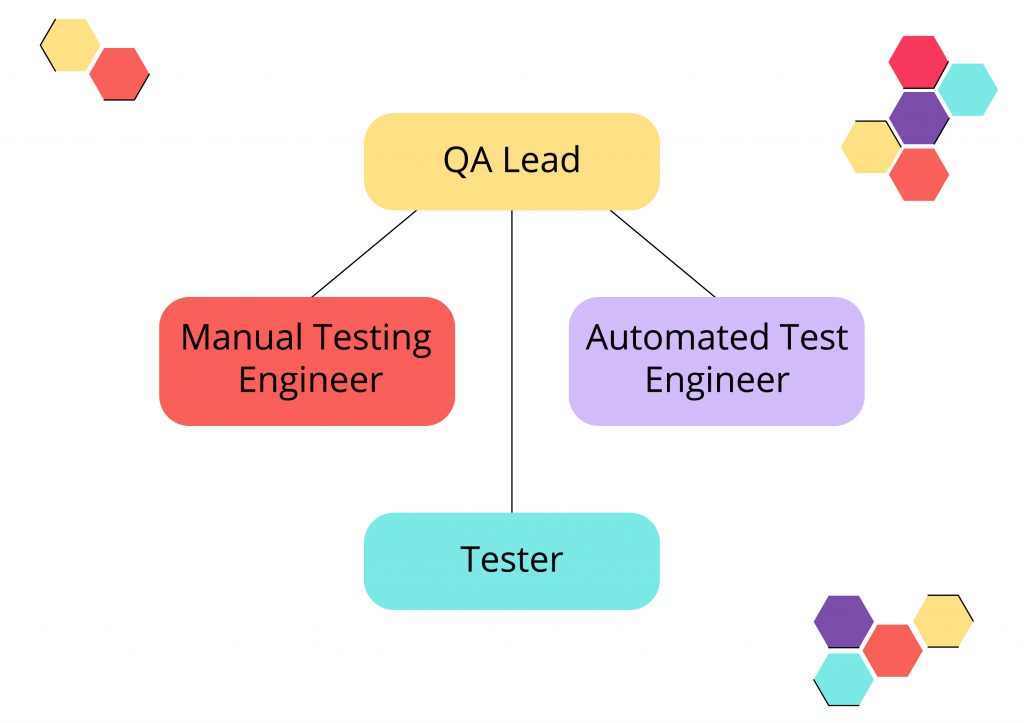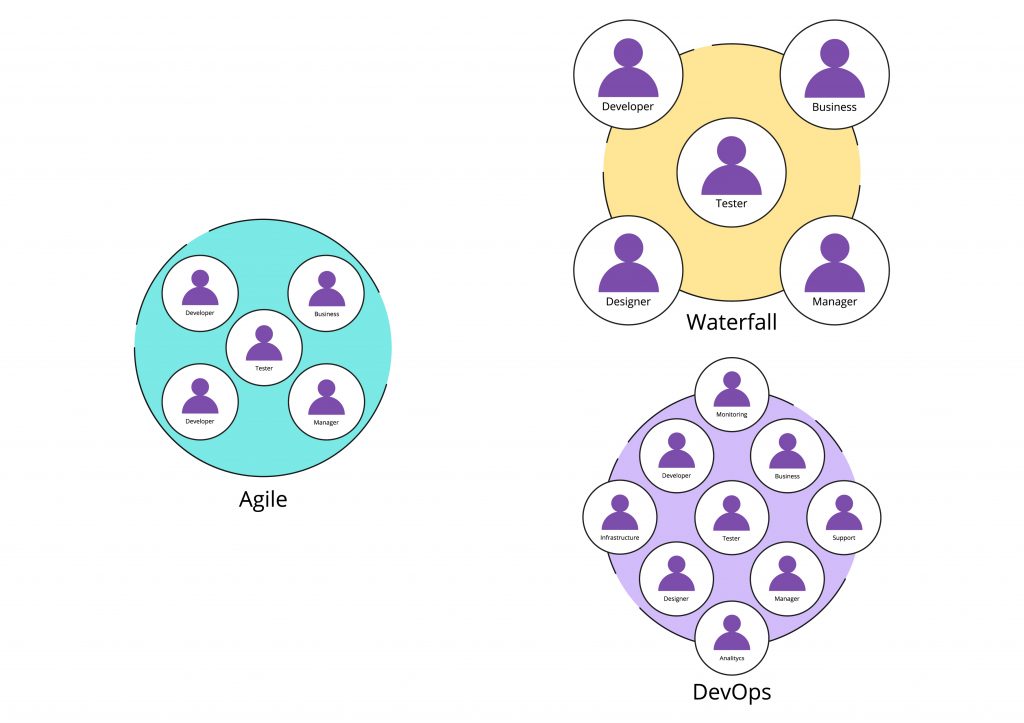What Does a Software Test Engineer Do During Software Development?

Quality assurance (QA) is an activity aimed at improving processes and delivering quality products to customers. Sometimes, quality assurance is confused with quality control (QC) because both detect bugs. However, while QC refers to the final product while QA means to fix bugs during its creation, detecting any issues that might block the successful operation of the software or even affect the user experience in the final product. Quality assurance testing is one of the phases of the software development life cycle (SDLC), so the role of a tester is no less important than a developer’s, even after the completion of the other development processes.
Any member of a testing team can be referred to as a tester or QA, but there are different testing activities, job titles, and hierarchies among testing team members, which also vary from one company to another. In this post, we will outline a generic team structure, and within it, each QA role and responsibilities.
Outline of a Software Testing Team

A good software testing team is a mix of specialists whose hard and soft skills are sufficient for a swift and successful testing of software under development. Many teams create a document that will regulate their personal and common tasks and responsibilities. This helps to stabilize the workflow. Usually, there are also separate documents for each team member that provide helpful information on task organization, schedule, recommended approach, deadlines, and all the details on quality standards and processes.
There are also specifications connected to expertise which can be defined from lowest to highest as a junior, middle and senior QA. You might also encounter job titles like a QA analyst, an automation engineer or developer, but in reality, they may all have similar responsibilities. Complicated titles are common within companies that have huge QA technical teams. They help to clarify the experience and competence of all specialists. However, the two essential QA roles are a manual testing engineer and an automated testing engineer. Let’s take a look at their responsibilities.
Tester
As was stated above, a tester is a general term that can refer to any specialist in the field. A typical tester has relevant domain knowledge, valid knowledge of test designing concepts, and an understanding of execution methodologies. They should also be capable of efficiently communicating with the development team. Typical responsibilities of a tester include:
- Creating test cases and documentation.
- Running tests according to the standards.
- Analyzing and reporting testing results.

Manual Testing Engineer / Manual QA Engineer
This type of tester relies on human observation skills to find bugs in a system which are sometimes hard to identify by automated tests alone. Typically, this is sufficient testing for a software product. A test plan regulates the workflow of manual testing engineers. Some of their responsibilities include:
- Understanding the requirements received from the customer.
- Test effort approximation. QA can always analyze how much effort and time is required to complete the testing.
- Bug reports. One of the main QA responsibilities is to document all deviations from the flow which was stated in the requirements.
- Documenting test cases. Creating test cases that should be logically divided into separate blocks called test suits.
- Noting ways for improvement. It is beneficial for everyone involved in development if QA can notice, not only bugs but also ways to improve an application.
- Daily reports. The team lead should be kept informed about testing activities daily.
- Highly experienced senior testing engineers can also contribute to test planning, strategy, and approximation.
Automated Test Engineer
An automated test is a script that allows a software QA engineer to run testing automatically. The responsibilities of an automation testing engineer are more complicated. They are sometimes named ‘developers in testing’ because they require sound programming skills to create automated test scripts. The automated testing aims to prevent time-wasting on routine testing activities and regression. So, what does a software test engineer do?
- Writing, executing and analyzing automated tests, including effective test scripts that help identify problematic issues.
- Documenting automated processes. Usually, this documentation comprises test plans, test cases, and procedures.
- Working with frameworks. There are testing frameworks which provide instruments to generate test cases more efficiently. Using such frameworks, a QA engineer reduces testing efforts and costs and makes the code itself reusable. Skilled senior automated test engineers can build an automation framework by themselves.
- Choosing new instruments. No matter how effective automated tests are, there is always room for improvement. Therefore, research and implementation of new instruments may fall into this QA’s tasks.

Test Manager / QA Lead
A product should meet quality standards and goals in time. The planning, organization, and supervision of the teamwork fall into the test lead responsibilities. QA lead role can be held by an experienced manual or automated QA engineer and can be viewed as having an additional scope of responsibilities. Particularly, they perform the following tasks:
- Test strategy. It’s a test manager’s job to decide what testing instruments for the testing team to use and to set up a test environment. He or she also needs to choose the templates for all the documentation and procedures.
- Setting metrics for measuring quality. One for defects, one for efficiency and/or regression, and one for quality assurance.
- Requirements clarification. A QA lead has to communicate with the customer to understand what they require and expect. Sound communication skills are a must.
- Supervision of the testing activities. The test manager develops plans for both test and budget, schedules testing activities, prepares test effort estimations, and keeps all the procedures in check. The performance of every testing team member is also his or her task.
- Testing team representative. The test manager attends all cross-department meetings requiring the testing team’s attention. He or she also keeps the customer up-to-date about testing activities for their project.
- Recruitment. QA lead takes part in picking candidates for the team and determines whether their knowledge is adequate for the job.
- Constant testing routine improvement. QA leads should always look for possibilities for improvement. This includes test techniques, automation, and instruments. If the testing team efforts produce unsatisfying results, the lead also has to define the problem and fix it.
QA Role and Responsibilities in the SDLC
The relationship between the testing team and other teams in a software development company has evolved from Waterfall to Agile, and now to DevOps.
The Waterfall scheme separates the software testing team and locks it in its domain with specified roles and responsibilities. Testing is planned by them separately from developers. They have some interaction, but are mainly ‘staying in their lane.’
However, nowadays, proactivity is expected from a QA testing team since they share the development team’s aim to guarantee the quality of the software product. The Agile environment, where final product quality is a collective responsibility, is much more collaborative than Waterfall. Every team is almost equally involved, all can share ideas, developers are involved in testing, and all communication with the business analyst, client, product owner, and others. But Agile can be limited because of a lack of support and operation teams.
On the other hand, DevOps creates a continuous cycle with testing conducted at every phase of software development. Because of this, the role of a tester today is expanding to participation in complicated development processes. DevOps also has some outside roles which include analytics and support. This is beneficial as these people add value to the testing, and QA shares data with them that is useful for their jobs, as well.

These days, the role of a tester is gaining more power both within a software project team and within a company. They are becoming full-stack software quality assurance engineers combining domain knowledge, testing experience, and technical skills with direct involvement in several development processes. The impact they provide results in higher levels of a software product quality.
Content created by our partner, Onix-systems.
 Home
Home